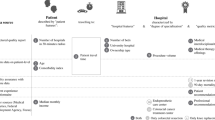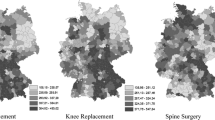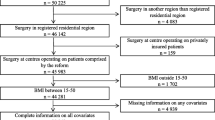Abstract
In the Dutch health care system, hospitals are expected to compete. A necessary condition for competition among hospitals is that patients do not automatically choose the nearest hospital, but are—at least to some extent—sensitive to differences in hospital quality. In this study, an analysis is performed on the underlying features of patient hospital choice in a setting where prices do not matter for patients as a result of health insurance coverage. Using claims data from all Dutch hospitals over the years 2008–2010, a conditional logit model examines the relationship between patient characteristics (age, gender and reoperations) and hospital attributes (hospital quality information, waiting times on treatments and travel time for patients to the hospitals) in the market for general non-emergency hip replacement treatments. The results show that travel time is the most important determinant in patient hospital choice. From our analysis, however, it follows that publicly available hospital quality ratings and waiting times also have a significant impact on patient hospital choice. The panel data used for this study (2008–2010) is rather short, which may explain why no coherent and persistent changes in patient hospital choice behaviour over time are found.
Similar content being viewed by others
Notes
At this moment, insurers are allowed to negotiate for 70 % of the total hospital services in the Netherlands.
In 2011/2012 health insurers started with selective contracting for different types of complex cancer surgery using minimum volume standards.
Recent numbers on the use of the website show an increase of 4.3 million users in 2009 to 4.9 million users in 2010. The awareness of this website in the Netherlands is currently about 18 % [9].
The NZa collects this data from DBC Information System (DIS), which is based on the registration by each institution for medical care of the performed combination of diagnose and treatment. The patient registration of the NZa only includes completed DTCs for which hospitals turned in a bill to a health insurer.
Mediquest is an independent research bureau collecting specialism-specific and disease-specific (including non-emergency hip replacement) waiting times per hospital. On behalf of patients’ choice information, Mediquest monthly delivers an update of actual waiting times to KiesBeter.nl.
Overall, correlations between the explanatory variables are weak, suggesting that multicollinearity is not likely to cause any problems.
Reoperation is a term used by surgeons for the duplication of a surgical procedure. This may involve surgery at the same site, at another site for the same condition, or to repair a feature from a previous surgery.
In the Netherlands, as in many other European countries, general practitioners (GPs) function as gatekeepers. Dutch GPs are, however, not responsible for choosing hospitals on the patient’s behalf. Patients choose hospitals themselves, though they are most often advised by their GP. In this paper, we assume GPs to be perfect agents for their patients, since they do not face financial incentives to behave otherwise and neglect patients’ preferences.
Likelihood ratio tests reveal that models with more explanatory variables are statistically preferred over the model with travel time alone. The results from these tests are available on request.
Unfortunately, our data do not include a rich set of patient characteristics.
To measure our model’s goodness-of-fit, based on Town and Vistness [15], a “hit-or-miss” criterion is constructed for model 3, where the predicted patient choice was the hospital with the highest predicted probability. The model correctly predicted about 70 % of patients’ hospital choices, suggesting a high degree of explanatory power. The accuracy of the model is also measured at an individual hospital level in a market share analysis. This is done by comparing the market share according to actual patient choices as observed in the claims data, with the market share predicted by the model (see Table 4).
Note that because the estimated coefficient for IGZ quality rating is counterintuitive and implausible, this variable is not included in the simulation analysis.
References
Beckert, W., Christensen, M., Collyer, K.: Choice of NHS-funded hospital services in England. Econ. J. 122(560), 400–417 (2012)
Bundorf, M.K., Chun, N., Goda, G.S., Kessler, D.P.: Do markets respond to quality information? The case of fertility clinics. J. Health Econ. 28(3), 718–727 (2009)
Dranove, D., Sfekas, A.: Start spreading the news: a structural estimate of the effects of New York hospital report cards. J. Health Econ. 27(5), 1201–1207 (2008)
Epstein, A.J.: Effects of report cards on referral patterns to cardiac surgeons. J. Health Econ. 29(5), 718–731 (2010)
Howard, D.H., Kaplan, B.: Do report cards influence hospital choice? The case of kidney transplantation. Inquiry 43(2), 150–159 (2006)
Marshall, M.N., Shekelle, P.G., et al.: Public reporting on quality in the United States and the United Kingdom. Health Aff. 22(3), 134–148 (2003)
McFadden, D.L.: Conditional logit analysis of qualitative choice behavior. In: Zarembka, P. (ed.) Frontiers in econometrics, pp. 105–142. Academic Press, New York (1974)
Pope, D.G.: Reacting to rankings: evidence from “America’s best hospitals”. J. Health Econ. 28(6), 1154–1165 (2009)
RIVM: Gebruik en waardering KiesBeter.nl 2010, RIVM Rapport 275102001, Bilthoven (2011)
Rothberg, M.B., Morsi, E., et al.: Choosing the best hospital: the limitations of public quality reporting. Health Aff. 27(6), 1680–1687 (2008)
Schut, F.T., Van de Ven, W.P.M.M.: Rationing and competition in the Dutch health-care system. Health Econ. 14(S1), S59–S74 (2005)
Sivey, P.: The effect of waiting time and distance on hospital choice for English cataract patients. Health Econ. 21(4), 444–456 (2012)
Tai, W.C., Porell, F.W., Adams, E.K.: Hospital choice of rural medicare beneficiaries: patient, hospital attributes, and patient–physician relationship. Health Serv. Res. 39(6p1), 1903–1922 (2004)
Tay, A.: Assessing competition in hospital care markets: the importance of accounting for quality differentiation. RAND J. Econ. 34(4), 786–814 (2003)
Town, R., Vistnes, G.: Hospital competition in HMO networks. J. Health Econ. 20, 733–753 (2001)
Train, K.: Discrete Choice Models with Simulation, 2nd edn. Cambridge University Press, Cambridge (2009)
Van de Ven, W.P.M.M., Schut, F.T.: Managed competition in the Netherlands: still work-in-progress. Health Econ. 18(3), 253–255 (2009)
Varkevisser, M., van der Geest, S.A.: Why do patients bypass the nearest hospital? An empirical analysis for orthopaedic care and neurosurgery in the Netherlands. Eur. J. Health Econ 8(3), 287–295 (2007)
Varkevisser, M., van der Geest, S.A., Schut, F.T.: Assessing hospital competition when prices don’t matter to patients: the use of time-elasticities. Int. J. Health Care Financ. Econ. 10(1), 43–60 (2010)
Varkevisser, M., van der Geest, S.A., Schut, F.T.: Do patients choose hospitals with high quality ratings? Empirical evidence from the market for angioplasty in the Netherlands. J. Health Econ. 31(2), 371–378 (2012)
Vrangbaek, K., Stergren, K., et al.: Patient reactions to hospital choice in Norway, Denmark, and Sweden. Health Econ. Policy Law 2(02), 125 (2007)
Author information
Authors and Affiliations
Corresponding author
Appendix
Rights and permissions
About this article
Cite this article
Beukers, P.D.C., Kemp, R.G.M. & Varkevisser, M. Patient hospital choice for hip replacement: empirical evidence from the Netherlands. Eur J Health Econ 15, 927–936 (2014). https://doi.org/10.1007/s10198-013-0535-7
Received:
Accepted:
Published:
Issue Date:
DOI: https://doi.org/10.1007/s10198-013-0535-7




